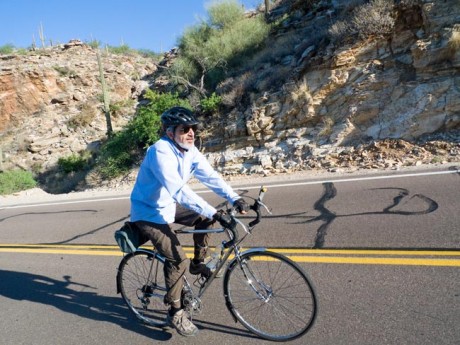
I’m a slow rider, at least partly because I want to be. But this summer, my first long ride on an expensive carbon bike got me thinking about speed.
A cycling friend took me on one his favorite rides west of Denver. I rode his spare Trek Madone up Willow Creek to the continental divide.
My own bike is a 1983 lugged steel Gilmour. I’ve probably put 75,000 miles on that bike through the years. No one has ever accused it or me of being speed machines.
I did go faster on the Madone, perhaps three to four miles an hour faster. Could the bike make that much difference?
Partly because of my attachment to my Gilmour, as I pedaled I started making a mental list of all of the things I do or have put on my bike that makes for a slower ride. Would my bike, stripped down and set up like his Madone, be just as quick up that hill? And if it were, would I even like it as much or ride it as often?
I like going slow on my bicycle for all kinds of reasons. I’ll write about those another time. Today, I thought I’d share my “slow and enjoy” list.
Floppy Clothes
Just after I grabbed a peanut butter and jelly sandwich at a rest stop between Durango and Silverton during the Bicycle Tour of Colorado, a volunteer bravely asked me, “Do you wear real cycling shorts under your khakis?”
That wasn’t the first time I heard the question so I was ready with my answer. “No, just boxers.”
I wear comfortable, floppy clothes. No lycra or spandex. I like cotton. Whether on my commute to work or on a multi-day tour, I generally wear a white or blue 100% cotton dress shirt and cotton slacks (and yes, boxers). I don’t ride fast, just fast enough for the wind to blow through the space between me and my shirt. It cools me off and allows me to arrive at my office dry, invigorated from a great ride, and ready for work; or, while on tour at the campsite or B&B, ready for some nice conversation over a nice glass of pinot grigio.
Flat Pedals
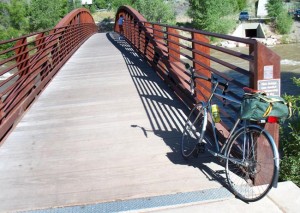
In anticipation of the Colorado Rocky Mountain Bicycle Tour, I took my bike back to “the mother ship,” Andy Gilmour’s space, where he builds some of the best custom frames in the country. It had been awhile since I’d seen him or since he’d seen my bike. He glanced over at my bike that he expertly designed and crafted for me back in 1983 and asked, “Where did you get those pedals from hell?”
I push heavy platform pedals. I gave up my toe clips and didn’t move to clip-in pedals. I installed wide, flat, platform pedals instead. They were great and couldn’t be easier to use. You slip on any pair of footwear. You walk to your bike, sling one leg over the top tube, and place a foot on whichever pedal is up, and push off.
Is it less efficient? I imagine. I can’t pull on the upstroke. But even when I rode toe clips and cleats, I never did anyway. I don’t imagine most people do. Sometimes I try to “un-weight” on the upstroke, but after a couple of minutes I forget and just go back to normal pedaling, or if I’m lucky, coasting. I imagine my flat pedals help me go slower, and that’s usually a good thing.
I’ve never experienced the required slow motion fall that clipped in people endure at least twice. I’ve never had knee problems. My feet don’t get numb and I haven’t experienced “hot foot,” even after 100 miles in the saddle or making it to the top of a 12,000 ft. Colorado pass.
If you ride platform pedals and need validation or if you are considering giving up your expensive clip-on pedals and shoes and want to know why that makes sense, here’s a great essay by the opinionated and wise Grant Pederson, owner/creator of Rivendell Bicycle Works. It’s called “The Shoes Ruse.”
Sandals

I usually ride in sandals. On the Bicycle Tour of Colorado, a guy rode up beside me and I noticed he glanced down at my feet. We were at 9,000 feet pedaling uphill at about a 6 percent grade. I was going slow, like I usually do, keeping a cadence of about 80. The fellow, both puzzled and good natured, said, “You can’t do that.” I said something intelligent and witty like, “Huh?” And he said, “Shoes. You’re not wearing shoes.”
My sandals felt great. My feet were cool and had plenty of room. Soles were thick enough so that I didn’t feel any concentrated pressure from the pedals, even on those rare times when I got out of the saddle. When that exchange occurred, I was wearing a pair of older Birkenstock knockoffs, all leather. Today I mainly ride in Keens. I like them so much that on my last two bike tours, each a week long, they were the only footwear I took along.
Fenders
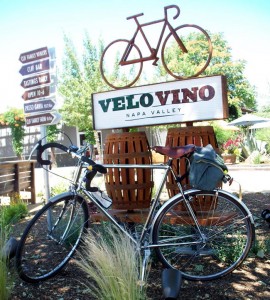
My bike wears fenders. Phil at Pima Street Bicycles (who appreciates good old bikes and is OK with cyclists going slow) calls my fenders “Air Brakes.”
I realize that in Tucson it’s kinda nutty to take on the added weight and air drag of fenders, but I like how they look. My Gilmour doesn’t feel quite dressed and ready for the day without fenders. They signal, at least to me, that I am a grown up bicyclist and this is my transportation and beyond that, my bike is a finished piece of functional art. Fenders tell people I’m not racing against them and it doesn’t matter whether I get to the stoplight at Mountain and Grant first.
It might be my imagination, but it feels as if my fenders keep my whole bike cleaner. And, if it does rain, it’s good manners. Fenders to keep all the wet road grit that you create from splattering in the eyes or on the clothes of the person or people behind you.
Phil found some slick leather washers that he placed between my fenders and my frame. My fenders are quiet, don’t vibrate, and tie the whole package together.
Triple Crankset
I use a triple crankset, and one from out of the early 80s at that. It’s made by TA, an old French company that has made bicycle touring gear for forever. The granny gear allows me to go slow going up any steep hill. Not so slow that walking/pushing the bike makes sense, but slow. I read that the chain rings flex. The arms are not hollow and they are not made of featherweight carbon. But slowly and surely, just as I prefer, they’ve gotten me up any hill I’ve attempted.
Freewheel
My bike has a freewheel, an old “Ultra 6.” Yes, that’s a six-speed freewheel, and it’s all the gearing I need. In fact, five or four cogs on the back would probably be fine, when combined with my triple crankset. The lack of those incremental gears and the supposedly lower efficiency that the freewheel offers probably slows me down a little. I’ve never noticed, but that’s fine. Meantime, I can pedal comfortably up just about any hill at between 5 and 6 miles an hour, and once I get to the top, I can coast down as fast as the road or my floppy clothes will let me.
Lights
I usually have lights mounted on my bike, front and rear. I don’t imagine the rear light contributes much to slowing me down, but the front one must. At least that’s what a wind tunnel would probably indicate. Not to mention the battery pack that straps onto my stem. But you never can tell when you might need to stay at work for a meeting or just want to stop by a restaurant with friends for a meal on the way home. It’s good to have some lights when you need them.
Mirror
My rear-view mirror takes up more that 7 square inches of space. It’s flat and it sticks out as far to my left as I can get it. That must contribute to slowing me down. And I can’t imagine riding without it. Not having a mirror on my bike feels like driving my car without a seat belt. My mirror earns its keep by making me safer and by adding some air resistance that keeps me riding at a nice easy pace.
Brooks Saddle
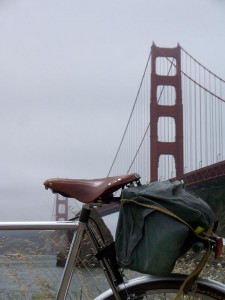
I use a Brooks B-17 saddle. During this summer’s Sierra to the Sea bike tour I’d pull into camp at about 4 p.m. Not an afternoon went by without someone, usually a guy in his 50s, coming up to me to ask about my Brooks. They’d compliment its looks. Mine is a pretty honey brown. Then they’d ask if they really are that much more comfortable than modern racing saddles. I’d make a (true) joke about how my leather saddle with steel rails weighs about 15% of what entire whole bike weighs and then tell them, it works for me. And always has. Butt pain is simply not an issue. At the end of El Tour, I’m of course ready to get off my bike, but my rear end doesn’t hurt. At all. Other riders find that hard to believe, are tempted to give it a try, but aren’t sure — especially when I remind them that the saddle, all two or more pounds of it, is one of the things that helps me go slower.
Carradice Bag
Always attached to that Brooks saddle is a large Carradice Nelson Longflap saddlebag supported by a steel bagman frame.
The classic British bicycle tourist always used a large seatbag rather than panniers. I learned about seatbags from my friend Ed. Now I never ride a bike without one.
They are made of heavy cotton duck or nylon. Mine is cotton. They are boxy and wide, all the better to catch wind and slow you down. They attach with leather or nylon straps to tabs on the Brooks B-17 saddle that were put there just for them.
They are best when supported by a steel frame (more weight) that attaches to the saddle’s rails and extends under the bag so it won’t flop around or sag.
And they hold a lot. Inside my saddlebag you’ll find (at minimum) a camera, kindle, tool kit, pump, tubes (usually 2 in case someone else needs one), some spare nylon straps in case the top flap won’t close, and extra water. There is also plenty of room for a gallon of fresh orange juice, a bottle of wine, and a loaf of bread from the Trader Joe’s at Campbell and River. My laptop fits easily. Depending on the time of year, it will easily accommodate a rain jacket or fleece and rain pants that I might have brought to work with me just in case.
I imagine jersey back pockets can carry lots of stuff, but I’d rather my back tire carry the extra weight instead of me.
Upright position
My position is fairly upright so I can catch a lot of air and also enjoy what’s going on around me. At the same time, I have to admit that gliding down Mt. Lemmon or from the top of Swan, I get into as tight a crouch as I can. I love hitting 43 and once in awhile 45. But normally one of the most effective things you can do to both slow down and be comfortable is to sit up.
My handlebars and my seat are just about even with each other. In addition to slowing me down, that position lets me see way more stuff (so I can sometimes stop to take my camera out of my saddle bag and take a picture or just appreciate the moment) and it keeps me more comfortable than I used to be when my handlebars were lower. There are plenty of things that I find “a pain in the neck”, but bicycling isn’t one of them. I don’t experience neck pain on my bike at all, and I attribute that to my upright position.
Wider tires
My tires are usually 28s rather than the 23s that racers prefer. I’m not sure whether my wider tires slow me down or not. Probably a little. The fact that racers and wannabe racers use the skinniest and highest pressure tires they can find tells me at least they think so. I get fewer flats and a more comfortable ride and still get to work in plenty of time or to camp by 4 when I ride 28s rather than 23s. I might try 32s if they fit under my fenders.
Lower pressure
I keep my front tire at about 75 and my rear tire at about 90.
I read an article by Jan Heine in Bicycle Quarterly where he strongly advocated lower tire pressures (I don’t think the actual article is online). He conducted and published tests that he said showed under some conditions, lower pressures can actually make you go faster. I was not sure about that but decided to give it a try anyway. I liked it. The ride seems smoother and in some ways just more pleasant. Faster? I don’t think so. It might ever be slower. But that’s fine.
Steel frame (nearly 30 years old)
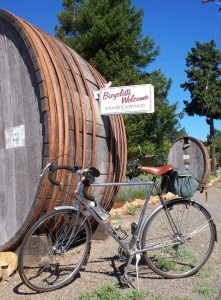
My frame is lugged steel. And it is chrome, which adds some weight.
My Gilmour bike feels great every time I’m on it. I like the feel of steel and it’s geometry is just right for what I use the bike for. Its 41-inch wheelbase adds to the bike’s stable ride, but it also feels great for reasons that don’t have to do with hardware.
Andy Gilmour, one of the country’s most experienced designer/builders, made the bike just for me in 1983. We talked about every aspect of the bike. Angles, clearances for fenders. Braze ons for racks, just where the cables would run.
The lugs have beautiful cut-outs in them, each handcrafted by a superbly talented Native American jeweler. Each lug is sculpted to show a two-armed saguaro cactus with the sun behind it. They remind me about how lucky I am to be able to ride in the Sonoran Desert just about any day of the year
In magazines, writers talk about frame fatigue. I haven’t noticed it. The bike looks new, but classic. The bike has at least 75,000 miles on it, all pedaled by me. That’s history, not fatigue, and history can help you slow you down as you appreciate even more the miles you pedal, and that’s nice.
Jay Rochlin has been riding bikes in Tucson for more than 40 years. He says he remembers a time when, if you saw a fellow Tucson cyclist wearing a helmet, you probably knew him or her.

Nice article!
Wonderful article! I really enjoyed reading it. 🙂
Awesome.
An excellent article that I not only enjoyed reading, but also can identify with. Your bike has more character/history than mine does, though.
Great article — thank you! I kept saying, “Yep, I do that too… yeah, that too…” (I ride a Surly LHT, not exactly a speed demon). And I agree that fenders keep your bike clean, even in dry weather — I think you get much less sand and grit thrown onto your chain by your rear tire.
And to think that riding slower is now fashionable. Sheez, I’ve been doing this for almost 35 years and didn’t know how cool I was.
Take it nice and slow, everyone!
I loved the article, Jay. I’ve gone so far with your thinking that I’ve added an extra wheel. I sit up, it’s a recumbent. I have fenders because Tucson has lots of people that over-water their landscaping and there’s streams and puddles in the road all the time. I must not be in too much of a hurry because half the time I haul my 56 pound dog around. I suppose that I differ from you in that I would enjoy a carbon bike to ride every once in a while. It wouldn’t get ridden often enough to justify the expense tho. My 1980 vintage Gilmour was lot’s of fun, but because I encouraged Andy to get the weight down as low as possible and because I’m 6′-2″, the frame was a flexy-flyer. A thief decided to lower the weight for me even more one day, he took 100% of it. I’m happy on my trike, and I’m especially happy when I occasionally bump into you. Take care.
the right 28 with lower pressure has lower rolling resistance than a narrow tyre running higher pressures.
http://www.bikeradar.com/news/article/bicycle-tires-puncturing-the-myths-29245/
this is quoted from the url aboveWider tires roll faster than narrower ones: Riders have argued for years that narrower tires – especially on the road – roll faster and are more efficient than wider ones when in fact, the opposite is true. According to Wheel Energy, the key to reducing rolling resistance is minimizing the energy lost to casing deformation, not minimizing how much tread is in contact with the ground. All other factors being equal, wider casings exhibit less ‘bulge’ as a percentage of their cross-section and also have a shorter section of deflected sidewall.The rougher the road the more this matters. Great article by the way. I ride a steel framed Davidson from the 80’s converted to fixed gear with a Brooks saddle 28’s because 32’s won’t fit and relatively heavy wheels, Open Pros with older Phil Wood track hubs laced 36. Of course if someone handed me a Calfee I’d ride heresy though it may be.
Great, great article. Best thing I read all day, and I read far too many internet articles for my own good.
Great, great article. Best thing I read all day, and I read far too many internet articles for my own good.
Viva the bar-end shifter!
If it weren’t for bar-end shifters, many fine bikes of this vintage and ridden in the way described would have been dumpstered by mass bike culture. Or worse: fixied.
Thanks. I’m glad you liked my little essay. I have to admit I sometimes feel a little bad about my own brand of reverse snobbery, but even so, I like my bike and riding it.
Thanks. I’m glad you liked my little essay. I have to admit I sometimes feel a little bad about my own brand of reverse snobbery, but even so, I like my bike and riding it.
Thanks for posting the link to the bikeradar article. Good information. Your bike sounds great. Davidson built super bikes. If you’re going to try a Calfee, maybe his bamboo bike?
Thanks Justin. I hope you and Sarah got to explore post-Irene Manhattan by bike.
Jay, You’re welcome. While I like going fast (and not just downhill), I appreciated your piece.
Yes, Professor Star, Bar end shifters are great. They just work and look good. That is the same set that Andy Gilmour installed on the bike in 1983.
This is true when comparing different sized tires of the same “model” at the same inflation pressure. You have to be careful making general statements as they don’t hold in all cases.
If someone gave me a Calfee I’d ride it. I’d never buy one but the bamboo frames are very intriguing. Did you see the bamboo tandem they had at the El Tour packet pick up last year? Really though I’m currently looking for another steel frame so I can get gears so that I can ride down hills. Going up is not the problem.
If someone gave me a Calfee I’d ride it. I’d never buy one but the bamboo frames are very intriguing. Did you see the bamboo tandem they had at the El Tour packet pick up last year? Really though I’m currently looking for another steel frame so I can get gears so that I can ride down hills. Going up is not the problem.
Nice article. Riders like you are why I started frame building … so you all have bikes to choose from. Keep on pedalin’.
Love the article. I, however, do wear lycra/spandex under my shorts because I’m fat and I need the “lubrication.” I also wear flip flops/sandals and have had people come up next to me at lights in disbelief that I would wear such things while riding.
My friend is a coach for “slow running”. I think you might be able to start your own camp for cyclists. Great article! So nice to have an alternative view. The beauty of cycling is that there is no one way to have fun doing it. Thanks!
I wear flip flops too when on my Dahon. My Fuji (upright) had toe clips but I have never tightened the straps, nor have I ever fallen. I can’t imagine buying pedals that require you to also buy special shoes.
You sir are a genius. I felt somehow inadequate because I rode my fathers 1960’s Schwinn until about ten years ago and then purchased a Trek road bike. I have now gone back to a Schwinn Willy and love it. I too am slow, and now you have helped me be proud of it. Thanks, Ed.
Ed, Thanks for your note. That’s great that you’re enjoying the classic Schwinn. The Trek has its place, for sure, but so does a slow comfy bike like your dad’s cruiser. Enjoy the ride wherever it takes you.
I like your article and viewpoint. Was just wondering though, what is slow? You wrote “I did go faster on the Madone, perhaps three to four miles an hour faster. Could the bike make that much difference?” 3-4 mph faster than what? If I lost another 3-4mph off my current average, I’d have trouble staying upright on inclines.
Thank you. I enjoy riding slow and being able to see everything. My bike of choice; Electra Townie (my newest is a tall 21 speed). It is the perfect tourist bike!
You said it all SO very well !